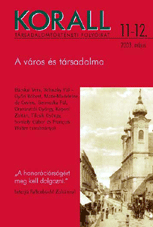Vásárok, vásárkörzetek és városok Erdélyben 1820-ban
Market Places and Towns of Transylvania in 1820
Author(s): Gábor SonkolySubject(s): History
Published by: KORALL Társadalomtörténeti Egyesület
Keywords: social history; urban history; Hungary; Transylvania; 19th century; tax; statistics; market place; overpopulation; urbanisation
Summary/Abstract: This article is a first attempt to define and analyse the system of Transylvanian market places on the basis of the 1820 tax roll, which is the only available source for this type of analysis from the period before regular censuses. Since the vast majority of the villages declared numerous market places, it is not possible to set up market areas exclusively dependent on one market centre (pure market area). The Principality of Transylvania could be rather characterised by a great number of market centres with overlapping market areas, which shows an important demand for exchange as well as an extended, but premature market system. Similarly to contemporary European urbanization trends, Transylvania is experiencing the phase of structural urbanization in the first third of the 19th century. The regional differences of Transylvanian could be highlighted by the statistical analysis of the market place declarations of the villages. The Northern part of the Principality is covered by numerous market places including the most important ones (Marosvásárhely/Targu Mures, Kolozsvár/Cluj) in the whole of Transylvania. In this region many villages declare more than ten market places, which shows the great demand for new economic solutions for the increasing problem of overpopulation. Though the 1820 tax roll does not include the Saxon part of the Principality, it is possible to sketch its market place structure based on the declarations from neighbouring areas. Here one can note a less numerous, but more mature market place system, in which the importance of a market place correlates with its size and administrative function. The Eastern part of Transylvania is characterized by a rather poor market system, in which some market place manage to establish a pure market area. Concerning the integration of the Transylvanian market place system to that of the neighbouring countries, there can be seen a strong relationship only between the North Eastern part of Hungary and the North Western part of Transylvania. Other borders do not seem to be crossed by important trade lines. Itmust be noted, however, that the tax roll analysis could not refer to long distance commerce.
Journal: Korall - Társadalomtörténeti folyóirat
- Issue Year: 2003
- Issue No: 11-12
- Page Range: 163-182
- Page Count: 20
- Language: Hungarian

